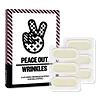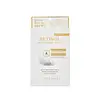What's inside
What's inside
 Key Ingredients
Key Ingredients

 Benefits
Benefits

 Concerns
Concerns

 Ingredients Side-by-side
Ingredients Side-by-side

Sodium Hyaluronate
HumectantCellulose Gum
Emulsion StabilisingTrehalose
HumectantGlycerin
HumectantPropanediol
SolventButylene Glycol
HumectantCaprylyl Glycol
EmollientRetinol
Skin ConditioningAdenosine
Skin ConditioningCarnosine
Skin ConditioningAscorbic Acid
AntioxidantPalmitoyl Tripeptide-1
Skin ConditioningBiotinoyl Hexapeptide-2 Amide
Skin ConditioningAcetyl Octapeptide-3
HumectantPalmitoyl Pentapeptide-4
Skin ConditioningPalmitoyl Tetrapeptide-7
Skin ConditioningAcetyl Hexapeptide-8
HumectantHeptasodium Hexacarboxymethyl Dipeptide-12
Skin ConditioningMelatonin
AntioxidantMadecassoside
AntioxidantEthylhexylglycerin
Skin ConditioningCarbomer
Emulsion StabilisingPolysorbate 80
EmulsifyingPolysorbate 20
Emulsifying1,2-Hexanediol
Skin ConditioningSodium Lactate
BufferingSodium Hyaluronate, Cellulose Gum, Trehalose, Glycerin, Propanediol, Butylene Glycol, Caprylyl Glycol, Retinol, Adenosine, Carnosine, Ascorbic Acid, Palmitoyl Tripeptide-1, Biotinoyl Hexapeptide-2 Amide, Acetyl Octapeptide-3, Palmitoyl Pentapeptide-4, Palmitoyl Tetrapeptide-7, Acetyl Hexapeptide-8, Heptasodium Hexacarboxymethyl Dipeptide-12, Melatonin, Madecassoside, Ethylhexylglycerin, Carbomer, Polysorbate 80, Polysorbate 20, 1,2-Hexanediol, Sodium Lactate
Sodium Hyaluronate
HumectantSucrose
HumectantAscorbyl Glucoside
AntioxidantCyclodextrin
AbsorbentWater
Skin ConditioningGlycine Soja Oil
EmollientSodium Hydroxide
BufferingPropylene Glycol
HumectantAllantoin
Skin ConditioningPolysorbate 80
EmulsifyingRetinol
Skin ConditioningPanthenol
Skin ConditioningAcetyl Octapeptide-3
HumectantCapsicum Frutescens Fruit Extract
Skin ConditioningArginine/Lysine Polypeptide
Skin ConditioningBHT
AntioxidantIngredients Explained
These ingredients are found in both products.
Ingredients higher up in an ingredient list are typically present in a larger amount.
Acetyl Octapeptide-3 is a synthetic peptide also commonly known as SNAP-8. It is a lab-made peptide often marketed as a gentler, topical alternative to Botox.
It works by mimicking part of a protein involved in muscle contractions, which may help relax facial tension and reduce the appearance of fine lines (mostly around the eyes and forehead).
It’s considered a “next-gen” version of Argireline (Acetyl Hexapeptide-8), an older peptide with more research behind it that also supports collagen production.
SNAP-8 showed slightly better results than Argireline in one small manufacturer-funded study, but there’s limited independent research. Plus, most tests use concentrations higher than what’s typically found in skincare products.
This ingredient might offer a subtle smoothing effect but it won't don’t deliver the dramatic results of actual Botox injections.
Think of it more like a supporting actor in your skincare lineup.
Learn more about Acetyl Octapeptide-3Polysorbate 80 is a surfactant and emulsifier. It is used to keep ingredients together, and prevent oils and waters from separating.
It is made from polyethoxylated sorbitan and oleic acid. This ingredient can be found in cosmetics, foods, and medicine. It is water-soluble.
Polysorbate 80 may not be fungal acne safe.
Learn more about Polysorbate 80Retinol is a gold-standard ingredient for anti-aging. It is a form of Vitamin A and belongs to the class of retinoids that also includes tretinoin.
Why is retinol famous?
It has the most scientific studies backing up its skin benefits out of all the non-prescription ingredients.
Retinol is proven to:
This is why retinol is effective at removing wrinkles, fading dark spots, treating acne, and reducing the appearance of pores.
Studies show retinol is less effective when exposed to UV. Be sure to look for appropriate packaging to keep your retinol potent (similar to Vitamin C).
Using retinol or any retinoids will increase sun-sensitivity in the first few months. Though studies show retinoids increase your skin's natural SPF with continuous use, it is best to always wear sunscreen and sun-protection.
We recommend speaking with a medical professional about using this ingredient during pregnancy.
Retinol may cause irritation in some people, so be sure to patch test. Experts recommend 'ramping up' retinol use: start using this ingredient once a week and work up to using it daily.
Read about Tretinoin
Learn more about RetinolSodium Hyaluronate is hyaluronic acid's salt form. It is commonly derived from the sodium salt of hyaluronic acid.
Like hyaluronic acid, it is great at holding water and acts as a humectant. This makes it a great skin hydrating ingredient.
Sodium Hyaluronate is naturally occurring in our bodies and is mostly found in eye fluid and joints.
These are some other common types of Hyaluronic Acid:
Learn more about Sodium Hyaluronate